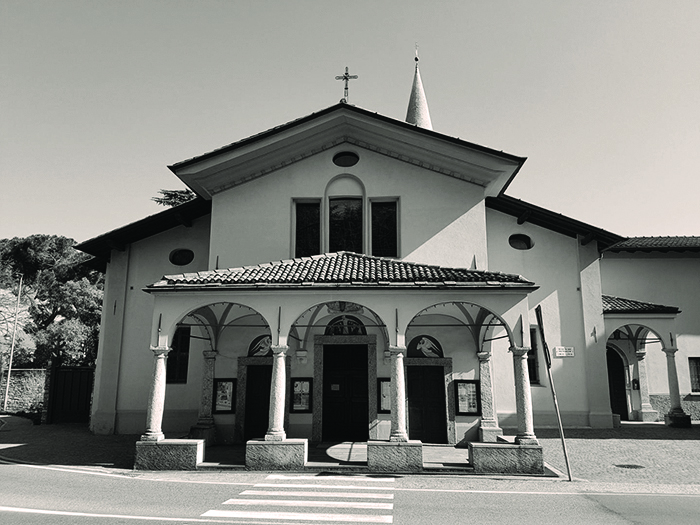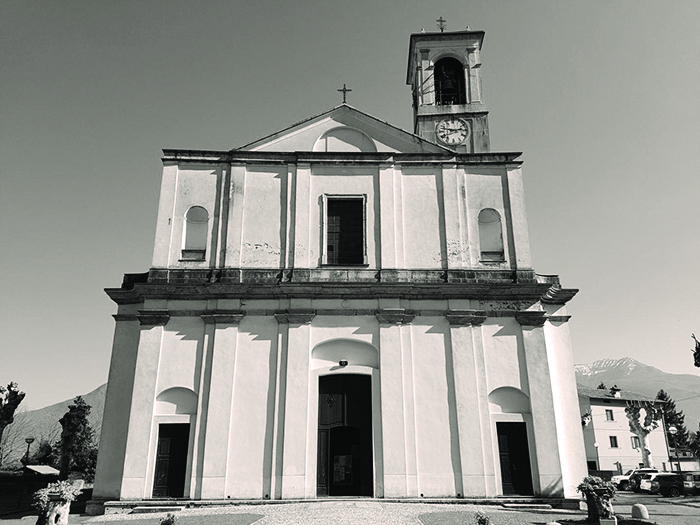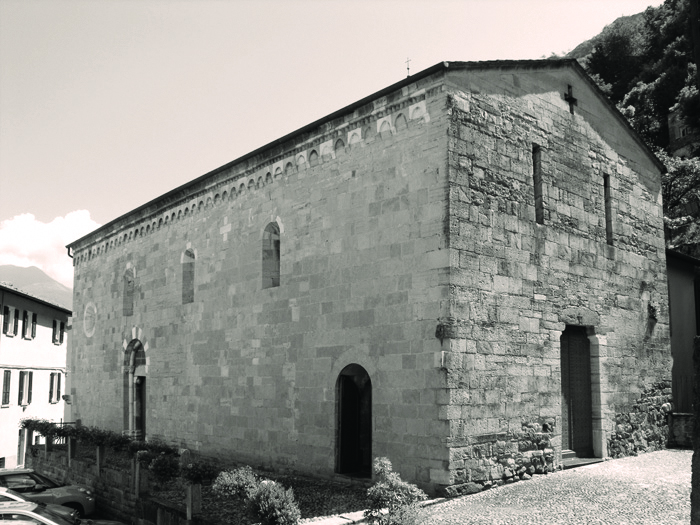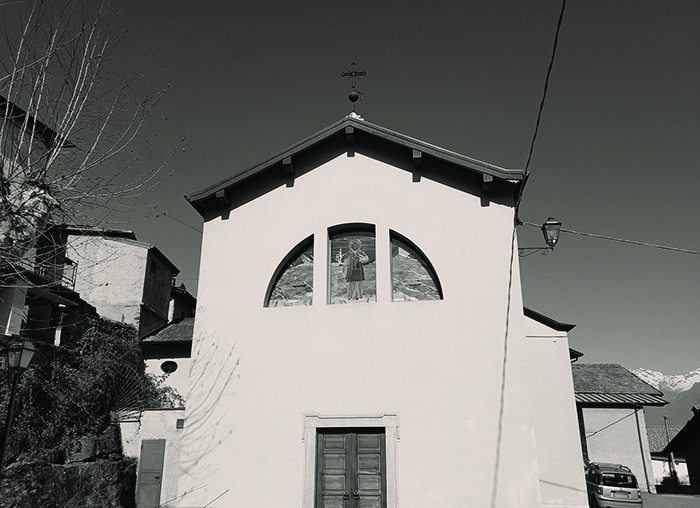Churches of Dongo
The Sanctuary of the Madonna of Tears.
It is said that the 6th September 1553, an image of the Madonna with Child was seen to shed tears inside a chapel which, after the miracle, was enlarge to become a church and then a Sanctuary, a destination for believers and pilgrims. The Sanctuary is set in the middle of Dongo, along via Regina and not far from the Albano river.
The Church is preceded by a four columns portico, above which opens three rectangular windows. Passed the door of the annexed Convent, there stand the belltower with four double lancet windows that lighten the square structure with a cone-shaped roof. The church is at one nave with lateral chapels (two at each side). The first chapel to the right id dedicated to Saint Francis and had a canvas portraying the Saint, supported by an Angel while is receiving the stigmata, work by Fra Girolamo Cotica da Premana while the frescoes are by Fra Emanuele da Como. The second chapel to the right is dedicated to the Crucifix with seven worthy wooden statues of the XVII century, work by Fra Diego Giurati da Careri a sculprurer from Calabria who came to Dongo in 1649.
The first chapel to the left is dedicated to Saint Antonio and preserves a statue of the Saint and frescoes by anonymous. The second chapel to the left is dedicated to the Last Supper with thirteen wooden statues; Jesus and his 12 Apostles, work by Fra Diego Giurati da Careri.
The Presbitery is decorated with frescoes dating 1599 signed by Gian Domenico Caresana da Cureia (valle di Lugano in Svizzera). The frescoes of the chapels of the Cucifix and of the Last Supper are by Andrea Gabasio il Pelagin (1603).

The Franciscan Convent.
The Convent is annexed to the church to which is possible to accede by three doors. Along the fencing wall of the vegetable garden of the convent, there opens some aedicule frescoed depicting S. Francis and Friar Masseo’s life and the Crib of Greccio (the very first one, invented by Saint Francis) works by F. Beltramelli.
The architectonic compound was built between 1607 and 1609 on a project by Anselmo Bianchi and includes:
1 - the Sanctuary, the Convent and the Belltower. The church is at une only nave with vaulted ceiling, two lateral chapels at each side, a deep rectangular presbytery, a vestry and some annexed rooms.
2 - The convent set on the southern side, is of square plan with double cloister as well as – 3 – the bell tower with a belfry lightened by double lancet windows and a cone-shaped roof. The roof of all the buildings consists in a wood girder covered with roman tiles.
The Parish Church of Santo Stefano.
This church is a real example of the eighteen-century way of building, inside which there is a profusion of decorations of that time. The church is set far from the village of Dongo, between the nowadays via Regina and the lake shore, not too far from the Sanctuary of the Madonna of Tears and its annexed Franciscan Convent of the XVI - XVII century.
It was documented as Parish Church since the XII century.
The parchment paper kept in the parish archives ascertain that on that very place there was a small church surrounded by a yard where local believers buried their dead in 1119.
In 1315, the church was rearranged and inside it was divided into three naves with apse, as it is still described in the documents of the pastoral visit of Bishop Ninguarda in 1593. In 1716, the late medieval architecture of the church was turned into a one nave church. During these works it was discovered a Christening font of the 15th century and sole pieces of frescoes and decorations of the gothic era.
The plain rectangular of the church is interrupted by pilasters with moulding capitals and a large floor-band divides it into two sections, which upper part ends with a gable. The 18th century belltower is of square plan also divided in sections by floor-bands and it ends with a belfry. For sure, the inside of the church is of Baroque taste, at one nave and vaulted ceiling, with a beautiful High Altar and four lateral Altars and worthy frescoes.
Half high the on walls opens ten niches with ten statues of stucco, work by Stefano Salterio. The Presbytery walls are frescoed with scenes of Saint Stephen’s life and death and its ribbed vault are frescoed with the allegory of the four cardinal virtues. In the recesses at each side of the presbytery are preserved the remains of the lateral apses of the fourteen-century church.

The church of Sancta Maria in Martinico.
Martinico is the most ancient hamlet of Dongo, set not far from the roman ancient via Regina.
By tradition, the toponymy of the settlement derives from the corruption of the name of the Monastery titled to Sancta Martha, which, probably, in ancient time was set there. Within seven roads and old yards opens a Small Square on which is set the Romanesque church dedicated to Our Lady of the Assumption.
For sure, this church is one of the oldest churches of Dongo and although it appears documented in 1299, its plain façade together with some other architectonic elements make it supposedly coeval to the S. Nocolò’s at Piona of the 12th century.
The building is at one only nave with an east-ward semi-circular apse.
The square belltower, which underwent to obvious rearrangements during the centuries, is set isolated from the church and it is lightened by double lancet windows although within its structure are still preserved some traces of the original building. Its plain shanty-shaped façade is broken by two slits and a cross-shaped window. The doorway is superposed by a lintel with a carved cross.
The western side of the church, the lateral doorway and the one on the façade are due to later works in respect to the year of the building itself between the 12th and the 13th century.
On the northern side opens a Romanesque doorway of the 12th century, supported by small columns ending with capitals and superposed by a lintel caved a with small human heads bass relive.
The apse and the lateral walls are decorated with arches and stones placed in a saw- tooth way, with both anthropomorphic and zoomorphic decorations.
On the walls inside the church there are still some traces of ancient frescoes of the 14th century. On the right hand-side there is the painting of the Madonna della Misericordia (our Lady of Mercy) dating 1310 – 1315. Of the same century is a second little cycle of frescoes on the right hand-side wall and on the counter-façade, which had been partially damaged by the later addiction of vaults which had been removed during the restoration works of in 1910-1912. The prophet painted on the right-side pillar of the Presbyterian arch, together with some other fragments of frescoes on the intrados belong to the 15th century.

The Church of Saint Gottardo.
In ancient times, on the little chapel set on a humbly and obscure place by the river Albano, was painted the image of Saint Gottardo, who was also worshipped by many folks of the surrounding villages.
It was June 21st 1652, when was set the first stone of the church dedicated to Saint Gottardo at Dongo.
In 1833 was added the fore-portico and in 1866 was bought a second bell. In 1902, the foreyard supporting wall collapsed, which was immediately rebuilt and enlarged to host the increasing number of believers.
The last works of restoration were made between 1938 and 1959.
.jpg)
The Church of Saint Lorenzo.
The one nave nowadays church had been built upon the remains of the previous Romanesque chapel which is thought of be coeval to the Church of Sancta Maria. Its plain shanty-shaped façade has a central doorway superposed by a semi-rose window divided into three parts by pilasters. The belltower is set at the back of the church. It is of square plan is interrupted by a floor-band and topped by a belfry with arched openings.
From the recorded acts of the pastoral visit Bishop Ninguarda made in 1593, we know that at that time, inside the church there was a painted Altar Piece portraying the Holy Virgin with Child among the Saints Lorenzo, Nicola and Antonio superposed by God Almighy; that the walls were frescoed although damaged by the Lutheran Grisons during the ferocious bloody religious war between Catholics and Lutherans which broke out in Valtellina and spread at lightening speed all through Europe.
Some restoration works were made between 1977 and 1978.

The Chapel at Barbignano.
Barbignano is one of the most ancient hamlet of Dongo, set along the ancient roman via Regina.
The building of this little church is bound to the figure of Maddalena Rebischini di Pietro, a woman devoted to Our Lady of the Sacred Heart of Gesus, who wished that these devotions would spread throughout the whole area. For this reason, in 1888 she bought at Paris a Statue of the Virgin 1,70 m. tall, made of roman papier-mâché, and had it sent to Dongo where she had it set into the Church of Sancta Maria di Martinico. Unfortunately, the niche prepared to host if turned out to be too tight, not finding any other solution, Mrs. Rebuschini decided to have a chapel built at Barbignano where people could worship Our Lady of the Sacred Heart of Jesus. She had the project and building done by Ing. Luigi Gentile.
At her death she left money enough to keep both the statue and the chapel forever open to the worship and in good order.